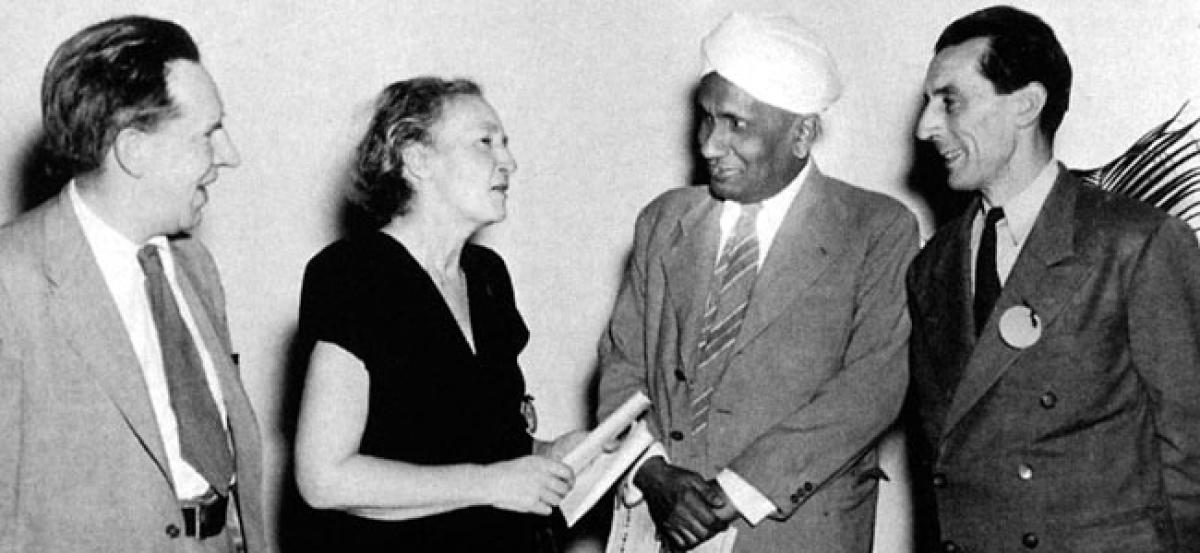Live
- Italian envoy Baroli hoping to strengthen ties with India through football
- CPI-M revokes suspension of Bengal party leader accused of sexual harassment
- Rachakonda Commissioner Emphasizes Health and Education at Uniform Diet Launch
- BJP leader visits late ASI Surendra Singh in Rajasthan, assures full govt support
- PM Modi tears into Gandhi family for its habit of amending Constitution
- Young Kabaddi Player Dies of Heart Attack During Match in Mandya
- Exciting Return of Santosh Trophy Football Tournament Kicks Off in Hyderabad
- Head Constable Dies by Suicide, Cites harssament by wife and inlaws
- Delhi BJP claims AAP govt will never pay women allowance like in Punjab
- India is 'Mother of Democracy': PM Modi
Just In

She discovered the missing part of the heart of matter but unfortunately didn\'t get the credit. Undeterred, she went on to advance her illustrious scientist mother\'s contribution by recreating in the lab a key natural phenomenon
She discovered the missing part of the heart of matter but unfortunately didn't get the credit. Undeterred, she went on to advance her illustrious scientist mother's contribution by recreating in the lab a key natural phenomenon, thus achieving the long human quest to transform substances -- and laying the foundation for manipulating the atom's immense energy for purposes beneficial and destructive.
But our modern and successful alchemist Irene Joliot-Curie, whose 120th birth anniversary is on Tuesday (Sep 12), was no ordinary person -- for no other woman, or any man for that matter, can match her scientific pedigree.
There are couples or fathers-and-sons who have both got the Nobel Prize, but she is the only one whose both parents, Pierre and Marie Curie, were laureates (her mother twice, in different disciplines) before winning it herself with her husband Frederic -- who was initially her pupil.
The Joliot-Curies were unlucky to miss winning the Nobel twice earlier, for the couple had found proof of the neutron, the missing component of atomic nuclei, as well as the positron, the electron's anti-particle counterpart, thus proving the existence of anti-matter. However, they failed to recognise the significance of their discoveries.
Both the near misses, however, led them to discover artificial radioactivity. While it was known that a nucleus could be split into stable parts on being bombarded with a sufficiently powerful particle, no one till the Joliot-Curies found out that "in certain circumstances, an unstable element in the process of nuclear decay could be created" and elements forced to release their energy in the form of radioactive decay (as per Diana Preston in "Before the Fallout: From Marie Curie to Hiroshima").
This won them the Nobel Prize for Chemistry in 1935, and led to studies of fission of heavy metals with all its implications on human health and power generation -- as well for a whole range of destructive weapons.
The eldest daughter of the famed Marie and Pierre Curie, Irene was born in Paris on September 12, 1897, and showed scientific aptitude early. When she was 10 years old, she was put into "The Cooperative" -- for which Madame Curie teamed with some of France's most distinguished academics, to teach at home each other's children a curriculum of both science and humanities.
After two years, she went back to traditional schooling, but this was interrupted by World War I. During the conflict, she helped her mother run her mobile field hospitals -- with primitive X-ray equipment which much helped doctors in locating shrapnel in wounded soldiers. However, these led to both mother and daughter suffering large doses of radiation exposure. (This, coupled with their literally "hands-on" approach to radioactive materials, would eventually cause their deaths.)
After the war, she returned to Paris to study at the Radium Institute, set up by her parents, and completed her doctorate in 1925. She became her prematurely frail mother's closest collaborator and a model of the oblivious, graceless scientist.
"Now in her mid-twenties, Irene was tall and sturdily built, with a direct, piercing, sometimes disconcerting gaze. Einstein thought she had the characteristics of a grenadier. Other contemporaries recalled her as sometimes haughty and conscious of her status as Marie Curie's daughter and at other times 'very uncouth'. She had little concern for appearances or convention, happily hiking her skirts to rummage in her petticoat for a handkerchief to blow her nose," Preston writes.
In 1924, Irene was asked to teach laboratory techniques to Frederic, a young chemical engineer, and went on to marry him in 1926. Hyphenating their surnames, they also combined their research efforts on atomic nuclei. Missing out on the neutron and the positron, they however achieved a place in the pantheon of science with the discovery of artificial radioactivity in 1934.
But Irene, despite her perceived lack of graces, was not entirely oblivious of the world. She, and her husband, were aware of the dangers of fascism and spoke out against it, while she also sought to promote science, being appointed France's Undersecretary of State for Scientific Research in 1936.
However, the long exposure to radioactive substances finally caught up with her. Contacting TB, she spent most of the Second World War convalescing in Switzerland. While she returned to both her political and scientific career after the war, she was diagnosed with leukaemia to which she succumbed to in 1956.
Continuing the tradition of the family's women, her daughter Helene (born 1927) became a nuclear physicist (son Pierre, b. 1932, became a biochemist).
By Vikas Datta

© 2024 Hyderabad Media House Limited/The Hans India. All rights reserved. Powered by hocalwire.com







